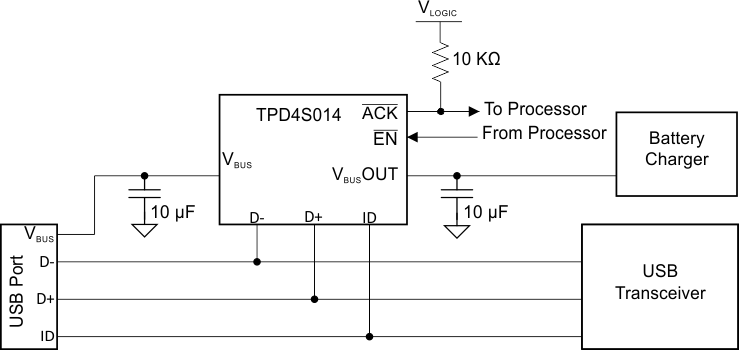ZHCS116G May 2011 – December 2015 TPD4S014
PRODUCTION DATA.
- 1 特性
- 2 应用范围
- 3 说明
- 4 修订历史记录
- 5 Pin Configuration and Functions
- 6 Specifications
-
7 Detailed Description
- 7.1 Overview
- 7.2 Functional Block Diagram
- 7.3
Feature Description
- 7.3.1 Input Voltage Protection at VBUS up to 28 V DC
- 7.3.2 Low RON nFET Switch
- 7.3.3 ESD Performance D+/D-/ID/VBUS Pins
- 7.3.4 Overvoltage and Undervoltage Lockout Features
- 7.3.5 Capacitance TVS ESD Clamp for USB2.0 Hi-Speed Data Rate
- 7.3.6 Start-up Delay
- 7.3.7 OVP Glitch Immunity
- 7.3.8 Integrated Input Enable and Status Output Signal
- 7.3.9 Thermal Shutdown
- 7.4 Device Functional Modes
- 8 Application and Implementation
- 9 Power Supply Recommendations
- 10Layout
- 11器件和文档支持
- 12机械、封装和可订购信息
1 特性
2 应用范围
- 手机
- 电子书
- 便携式媒体播放器
- 数码摄像机
3 说明
TPD4S014 是一款用于 USB 充电器端口保护的单芯片解决方案。该器件为 D+、D- 提供低电容瞬态电压抑制器 (TVS) 静电放电 (ESD) 钳位并为 ID 引脚提供标准电容。该器件在 VBUS 引脚提供直流电压高达 28V 的过压保护 (OVP)。过压锁定功能可确保当 VBUS 线路出现故障情况时,TPD4S014 能够隔离 VBUS 线路,从而避免内部电路受损。VBUS 升至欠压锁定 (UVLO) 阈值后存在 17ms 开机延迟,从而在 nFET 导通前使电压趋于稳定。该功能可去除毛刺脉冲并避免因线路连接过程中出现的任何振铃问题导致意外开关。
器件信息(1)
| 器件型号 | 封装 | 封装尺寸(标称值) |
|---|---|---|
| TPD4S014 | WSON (10) | 2.00mm x 2.00mm |
- 要了解所有可用封装,请见数据表末尾的可订购产品附录。
简化框图
